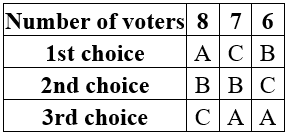2.16: Ejercicios
- Page ID
- 110520
\( \newcommand{\vecs}[1]{\overset { \scriptstyle \rightharpoonup} {\mathbf{#1}} } \)
\( \newcommand{\vecd}[1]{\overset{-\!-\!\rightharpoonup}{\vphantom{a}\smash {#1}}} \)
\( \newcommand{\id}{\mathrm{id}}\) \( \newcommand{\Span}{\mathrm{span}}\)
( \newcommand{\kernel}{\mathrm{null}\,}\) \( \newcommand{\range}{\mathrm{range}\,}\)
\( \newcommand{\RealPart}{\mathrm{Re}}\) \( \newcommand{\ImaginaryPart}{\mathrm{Im}}\)
\( \newcommand{\Argument}{\mathrm{Arg}}\) \( \newcommand{\norm}[1]{\| #1 \|}\)
\( \newcommand{\inner}[2]{\langle #1, #2 \rangle}\)
\( \newcommand{\Span}{\mathrm{span}}\)
\( \newcommand{\id}{\mathrm{id}}\)
\( \newcommand{\Span}{\mathrm{span}}\)
\( \newcommand{\kernel}{\mathrm{null}\,}\)
\( \newcommand{\range}{\mathrm{range}\,}\)
\( \newcommand{\RealPart}{\mathrm{Re}}\)
\( \newcommand{\ImaginaryPart}{\mathrm{Im}}\)
\( \newcommand{\Argument}{\mathrm{Arg}}\)
\( \newcommand{\norm}[1]{\| #1 \|}\)
\( \newcommand{\inner}[2]{\langle #1, #2 \rangle}\)
\( \newcommand{\Span}{\mathrm{span}}\) \( \newcommand{\AA}{\unicode[.8,0]{x212B}}\)
\( \newcommand{\vectorA}[1]{\vec{#1}} % arrow\)
\( \newcommand{\vectorAt}[1]{\vec{\text{#1}}} % arrow\)
\( \newcommand{\vectorB}[1]{\overset { \scriptstyle \rightharpoonup} {\mathbf{#1}} } \)
\( \newcommand{\vectorC}[1]{\textbf{#1}} \)
\( \newcommand{\vectorD}[1]{\overrightarrow{#1}} \)
\( \newcommand{\vectorDt}[1]{\overrightarrow{\text{#1}}} \)
\( \newcommand{\vectE}[1]{\overset{-\!-\!\rightharpoonup}{\vphantom{a}\smash{\mathbf {#1}}}} \)
\( \newcommand{\vecs}[1]{\overset { \scriptstyle \rightharpoonup} {\mathbf{#1}} } \)
\( \newcommand{\vecd}[1]{\overset{-\!-\!\rightharpoonup}{\vphantom{a}\smash {#1}}} \)
- Para decidir sobre un nuevo diseño de sitio web, el diseñador pide a la gente clasificar tres diseños que han sido creados (etiquetados A, B y C). A continuación se muestran las boletas individuales. Crear una tabla de preferencias.
ABC, ABC, ACB, BAC, BCA, BCA, ACB, CAB, CAB, BCA, ACB, ABC
- Para decidir sobre una película para ver, un grupo de amigos votan por una de las opciones (etiquetada A, B y C). A continuación se muestran las boletas individuales. Crear una tabla de preferencias.
TAXI, CBA, BAC, BCA, CBA, ABC, ABC, CBA, BCA, CAB, CAB, BAC
- El comité de planeación de una feria de energías renovables está tratando de decidir en qué ciudad celebrar su próxima feria. A continuación se muestran los votos.
\ (\ begin {array} {|c|c|c|c|c|}
\ hline\ textbf {Número de votantes} &\ textbf {9} &\ textbf {19} &\ textbf {11} &\ textbf {8}\\
\ hline\ textbf {1st choice} &\ text {Buffalo} &\ text {Atlanta} &\ text {Chicago} &\ texto {Búfalo}\\
\ hline\ textbf {2a opción} &\ text {Atlanta} &\ text {Buffalo} &\ text {Buffalo} &\ text {Chicago}\\\ hline
\ textbf {3a opción} &\ text {Chicago} &\ text {Chicago} &\ text {Atlanta} &\ text {Atlanta} &\ text {Atlanta}\
\ hline
\ end {array}\)
- ¿Cuántos votantes votaron en esta elección?
- ¿Cuántos votos se necesitan para la mayoría? ¿Una pluralidad?
- Encuentra al ganador bajo el método de pluralidad.
- Encuentra al ganador bajo el Método de Recuento de Borda.
- Encuentra al ganador bajo el método Instant Runoff Votion.
- Encuentra al ganador bajo el método de Copeland.
- Una agencia sin fines de lucro está eligiendo un nuevo presidente de la junta. A continuación se muestran los votos.
\ (\ begin {array} {|c|c|c|c|c|}
\ hline\ textbf {Número de votantes} &\ mathbf {1 1} &\ mathbf {5} &\ mathbf {1 0} &\ mathbf {3}\\ hline
\ textbf {1st choice} &\ text {Atkins} &\ text {Cortez} &\ text {Cortez} &\ text {} &\ texto {Atkins}\\
\ hline\ textbf {2nd choice} &\ text {Cortez} &\ text {Burke} &\ text {Cortez} &\ text {Burke}\\ hline
\ textbf {3a opción} &\ text {Burke} &\ text {Atkins} &\ text {Atkins} &\ text {Atkins} &\ text {Cortez}\
\ hline
\ end {array}\)
- ¿Cuántos votantes votaron en esta elección?
- ¿Cuántos votos se necesitan para la mayoría? ¿Una pluralidad?
- Encuentra al ganador bajo el método de pluralidad.
- Encuentra al ganador bajo el Método de Recuento de Borda.
- Encuentra al ganador bajo el método Instant Runoff Votion.
- Encuentra al ganador bajo el método de Copeland.
- El gobierno estudiantil realiza elecciones para presidente. Hay cuatro candidatos (etiquetados A, B, C y D por conveniencia). El horario de preferencia para la elección es:
\ (\ begin {array} {|c|c|c|c|c|c|c|}
\ hline\ textbf {Número de votantes} &\ mathbf {1 2 0} &\ mathbf {5 0} &\ mathbf {4 0} &\ mathbf {9 0} &\ mathbf {6 0} &\ mathbf {1 0 0}\
\ hline\ tbtbf {1ª opción} &\ mathrm {C} &\ mathrm {B} &\ mathrm {D} &\ mathrm {A} &\ mathrm {A} &\ mathrm {D}\\ hline
\ textbf {2a opción} &\ mathrm {D} &\ mathrm {C} &\ mathrm {A} &\ mathrm {C} &\ mathrm {D} &\ mathrm {B}\\ hline
\ textbf {3a opción} &\ mathrm {B} &\ mathrm {B} &\ mathrm {A} &\ mathrm {B} &\ mathrm {B} &\ mathrm {C} & amp;\ mathrm {A}\\
\ hline\ textbf {4ta opción} &\ mathrm {A} &\ mathrm {D} &\ mathrm {C} &\ mathrm {D} &\ mathrm {B} &\ mathrm {C}\
\ hline
\ end {array}\)
- ¿Cuántos votantes votaron en esta elección?
- ¿Cuántos votos se necesitan para la mayoría? ¿Una pluralidad?
- Encuentra al ganador bajo el método de pluralidad.
- Encuentra al ganador bajo el Método de Recuento de Borda.
- Encuentra al ganador bajo el método Instant Runoff Votion.
- Encuentra al ganador bajo el método de Copeland.
- La asociación de propietarios está decidiendo un nuevo conjunto de estándares vecinales para arquitectura, mantenimiento de patios, etc. Se han propuesto cuatro opciones. Los votos son:
\ (\ begin {array} {|c|c|c|c|c|c|c|}
\ hline\ textbf {Número de votantes} &\ mathbf {8} &\ mathbf {9} &\ mathbf {1 1} &\ mathbf {7} &\ mathbf {7} &\ mathbf {5}\\ hline\ textbf {1a opción} &\ mathbf {5}\\ hline
\ textbf {1a opción} &\ mathbf {5}\\ hline\ textbf texto {B} &\ texto {A} &\ texto {D} &\ texto {A} & \ texto {B} &\ texto {C}\\
\ hline\ textbf {2ª opción} &\ texto {C} &\ texto {D} &\ texto {B} &\ texto {B} &\ texto {A} &\ texto {D}\
\ hline\ textbf {3a opción} &\ texto {A} &\ texto {C} &\ texto {C} &\ texto {D} y\ texto {C} &\ texto {A}\\
\ hline\ textbf {4ta opción} &\ texto {D} &\ texto {B} &\ texto {A} &\ texto {C} &\ texto {D} &\ texto {B}\
\ hline
\ final {matriz}\)
- ¿Cuántos votantes votaron en esta elección?
- ¿Cuántos votos se necesitan para la mayoría? ¿Una pluralidad?
- Encuentra al ganador bajo el método de pluralidad.
- Encuentra al ganador bajo el Método de Recuento de Borda.
- Encuentra al ganador bajo el método Instant Runoff Votion.
- Encuentra al ganador bajo el método de Copeland.
- Considera una elección con 129 votos.
- Si hay 4 candidatos, ¿cuál es el menor número de votos que podría tener un candidato de pluralidad?
- Si hay 8 candidatos, ¿cuál es el menor número de votos que podría tener un candidato de pluralidad?
- Considera una elección con 953 votos.
- Si hay 7 candidatos, ¿cuál es el menor número de votos que podría tener un candidato de pluralidad?
- Si hay 8 candidatos, ¿cuál es el menor número de votos que podría tener un candidato de pluralidad?
- ¿Este sistema de votación tiene un Candidato Condorcet? Si es así, encuéntralo.
\ (\ begin {array} {|c|c|c|c|}
\ hline\ textbf {Número de votantes} &\ mathbf {1 4} &\ mathbf {1 5} &\ mathbf {2}\
\ hline\ textbf {1a opción} &\ mathrm {A} &\ mathrm {C} &\ mathrm {B}\
\\ hline\ tbf {2a opción} &\ mathrm {B} &\ mathrm {B} &\ mathrm {C}\\
\ hline\ textbf {3a opción} &\ mathrm {C} &\ mathrm {A} &\ mathrm {A}\\
\ hline
\ end {array}\)
- ¿Este sistema de votación tiene un Candidato Condorcet? Si es así, encuéntralo.

- El comité de mercadotecnia de una empresa decide votar sobre un nuevo logotipo de la compañía. Deciden utilizar el voto de aprobación. Sus resultados se cuentan a continuación. Cada columna muestra el número de electores con el voto de aprobación particular. ¿Qué logotipo gana bajo votación de aprobación?
\ (\ begin {array} {|c|c|c|c|}
\ hline\ textbf {Número de votantes} &\ mathbf {8} &\ mathbf {7} &\ mathbf {6}\
\\ hline\ textbf {1a opción} &\ mathrm {A} &\ mathrm {C} &\ mathrm {B}
\\ hline\ tbf {2ª opción} &\ mathrm {B} &\ mathrm {B} & ;\ mathrm {C}\\
\ hline\ textbf {3a opción} &\ mathrm {C} &\ mathrm {A} &\ mathrm {A}\\
\ hline
\ end {array}\)
- La asociación empresarial del centro está eligiendo un nuevo presidente, y decide utilizar la votación de aprobación. El recuento se encuentra a continuación, donde cada columna muestra el número de electores con el voto de aprobación particular. ¿Qué candidato gana bajo votación de aprobación?
\ (\ begin {array} {|c|c|c|c|c|c|c|c|c|}
\ hline\ textbf {número de votantes} &\ mathbf {8} &\ mathbf {7} &\ mathbf {6} &\ mathbf {3} &\ mathbf {4} &\ mathbf {2} &\ mathbf {5}\
\ hline\ mathbf bf {A} &\ mathrm {X} &\ mathrm {X} & & &\ mathrm {X} & & ;\ mathrm {X}\
\ hline\ mathbf {B} &\ mathrm {X} &\ mathrm {X} &\ mathrm {X} & &\ mathrm {X} &\
mathrm {X}\\ hline\ mathbf {C} &\ mathrm {X} &\ mathrm {X} &\ mathrm {X} &\ mathrm {X} &\
\ hline\ mathbf {D} &\ mathrm {X} & ; &\ mathrm {X} &\ mathrm {X} &\ mathrm {X} &\\
\ hline
\ end {matriz}\)


